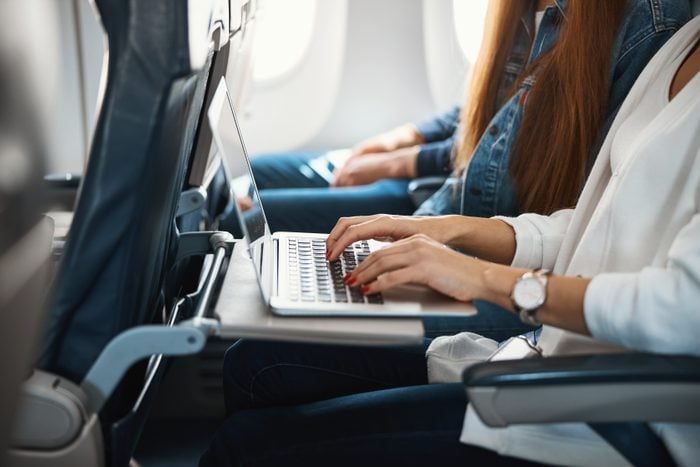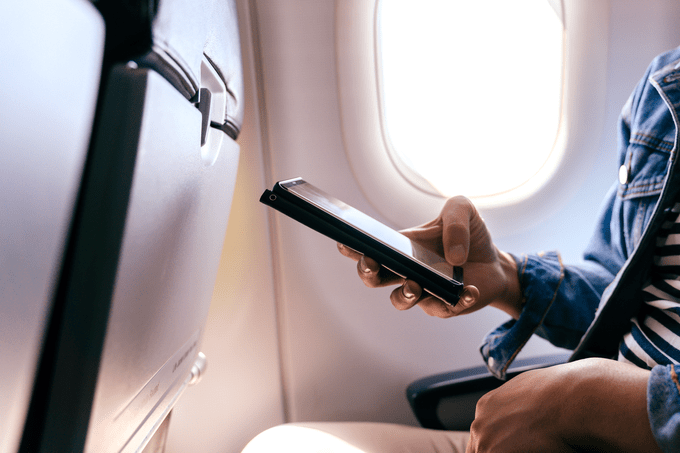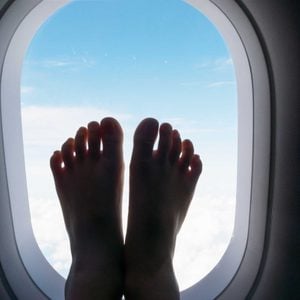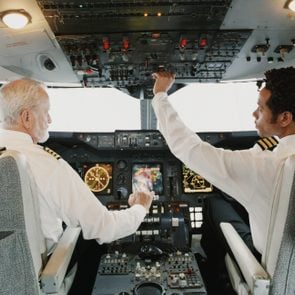How Does In-Flight Wi-Fi Work, Anyway?
Updated: Jan. 31, 2023

Ever wonder how you're able to use the Internet 36,000 feet above the ground? Here's how in-flight Wi-Fi keeps you connected.
Having to put your devices on airplane mode—or turn them off entirely—while on an airplane is frustrating, especially when you’re on a business trip and need to stay in touch with the office or are flying with kids on a long-haul journey. It’d be great if you could keep using the Internet as you make your way from here to there. But do airplanes have Wi-Fi?
Good news: More and more airlines are making in-flight Wi-Fi available, so you can stay connected midair. But how in the world does it work 36,000 feet above the earth? And what does Wi-Fi stand for, anyway? The simple answer: It’s an airplane feature you may not be taking full advantage of. Let’s get science-y and soak up all the airplane facts you never knew could enhance your traveling experience.
Can you use the Internet on an airplane?
The answer to this question depends on the airline, your travel route, and the model of the aircraft, but for all intents and purposes, yes, you can use the Internet on many airplanes, thanks to the in-flight Wi-Fi. And the number of airlines offering in-flight Wi-Fi is increasing rapidly with demand.
You may need to book directly with the airline, and some operators require a single-use pass or package from a provider such as Gogo. This is also a useful option if you fly frequently with different airlines. The price is usually higher for greater bandwidth, but if you need to get work done midair, it may be worth the investment. Otherwise, your time is just as well spent reading a book, taking a snooze, or gazing out the airplane window.
How does in-flight Wi-Fi work?
There are two operating systems for airplane Wi-Fi: ground-based and satellite. Air-to-ground Wi-Fi works in a way similar to your cell phone. An airplane has an antenna located underneath its body, which links up with cell towers. As the aircraft travels, it simply connects to the nearest transmitter on a rolling basis.
The airplane becomes a hot spot, so passengers can do everything they would normally do when connected to the Internet, including sending emails, making calls, and even streaming movies. But this system can’t work when the plane is flying over large expanses of water, like on transatlantic routes. That’s where satellite comes in.
Satellite Wi-Fi uses a network of orbiting satellites to allow a connection. The satellite is linked to ground stations, and the airplane connects using a satellite antenna on the top of the aircraft. The plane uses whichever satellite is nearest as it travels. Satellite Wi-Fi operates on two different bandwidths: narrowband and broadband. Both allow passengers full Internet access, although narrowband is less suitable for streaming movies.
How do you get Wi-Fi on a plane?

Airlines will typically let travelers know about in-flight Wi-Fi when they buy plane tickets and again once boarding or onboard the aircraft. It usually involves turning your device’s Airplane mode on, then finding the in-flight Wi-Fi in the Wi-Fi settings or in a web browser.
There may be certain times when the Wi-Fi connection isn’t strong enough mid-flight, making it harder to connect or stream. Additionally, certain planes may not be equipped with the antennae needed for Wi-Fi.
Fortunately, in the near future, in-flight Wi-Fi connectivity is poised to improve across the board. Technology such as Gogo’s 2Ku system is steadily improving reliability, which is enabling more airlines to introduce Wi-Fi for both domestic and international flights.
Do airplanes have their own Wi-Fi?
While some airlines like Delta market their Wi-Fi under their own brand, that’s not exactly how it works. Because in-flight Wi-Fi relies on a connection to cell towers or satellites, the Wi-Fi is simply whatever is nearest; the plane just acts as a hot spot.
Is Wi-Fi on airplanes free?
It depends on the airline. While some offer free Wi-Fi, other providers charge travelers a certain amount for in-flight Wi-Fi, typically based on the amount of time connected.
For example, JetBlue offers standard free Wi-Fi service on all domestic flights, while Delta Air Lines and Alaska Airlines offer free texting over Wi-Fi on all flights, with Alaska Airlines charging an additional $8 for Wi-Fi on most domestic flights. If you’re a frequent flyer, airlines like Delta and Alaska Airlines also offer monthly and annual Internet passes.
Some airlines charge around $10 for in-flight Wi-Fi, while others are testing trials of free Wi-Fi for passengers with hopes of implementing it permanently in the future. If you plan on using open Wi-Fi at any point during your trip, make sure you know the risks and how to use it properly.
Easy Internet access is awesome—though you may hear an airplane sound letting you know you’ll need to turn off your in-flight Wi-Fi for a portion of the flight. So, as in-flight Wi-Fi becomes as commonplace as beverage service, the rules, connectivity, and prices are destined to change. Until then, learn more about how many planes are in the sky right now, why “airplane” is sometimes also spelled “aeroplane,” why it’s cold on airplanes, and how airplane toilets work.
Additional reporting by Elizabeth Manneh.
Sources:
- Fortune: “Here’s How You Actually Get Wi-Fi on Your Flight”
- JetBlue: “Fly-Fi: Fast, Free Wi-Fi”
- Alaska Airlines: “Wi-Fi for Just $8”
- Delta: “Onboard Wi-Fi & Free Messaging”


